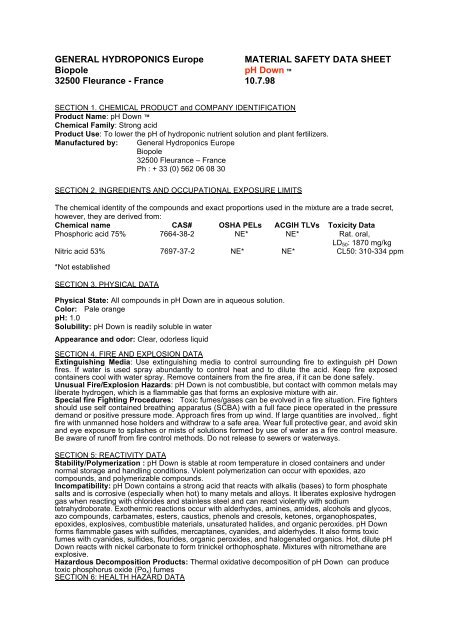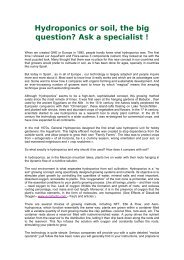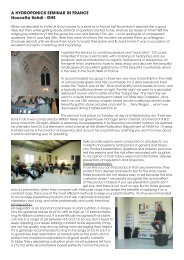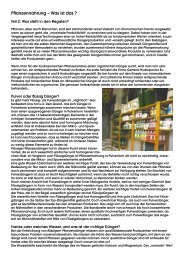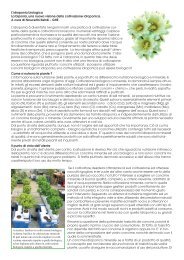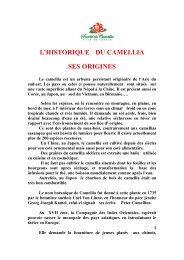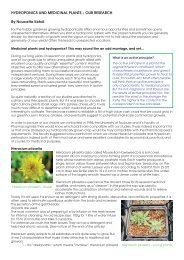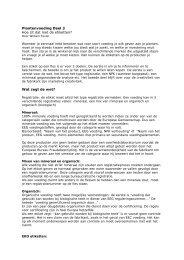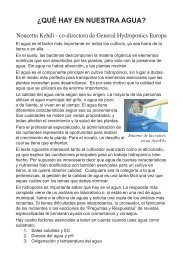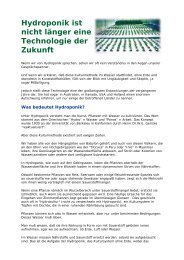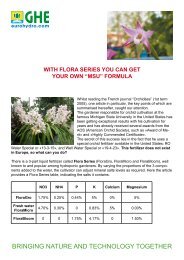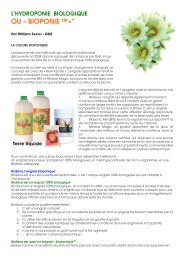pH Down - General Hydroponics Europe
pH Down - General Hydroponics Europe
pH Down - General Hydroponics Europe
Create successful ePaper yourself
Turn your PDF publications into a flip-book with our unique Google optimized e-Paper software.
GENERAL HYDROPONICS <strong>Europe</strong> MATERIAL SAFETY DATA SHEET<br />
Biopole <strong>pH</strong> <strong>Down</strong> <br />
32500 Fleurance - France 10.7.98<br />
SECTION 1. CHEMICAL PRODUCT and COMPANY IDENTIFICATION<br />
Product Name: <strong>pH</strong> <strong>Down</strong> <br />
Chemical Family: Strong acid<br />
Product Use: To lower the <strong>pH</strong> of hydroponic nutrient solution and plant fertilizers.<br />
Manufactured by: <strong>General</strong> <strong>Hydroponics</strong> <strong>Europe</strong><br />
Biopole<br />
32500 Fleurance – France<br />
Ph : + 33 (0) 562 06 08 30<br />
SECTION 2. INGREDIENTS AND OCCUPATIONAL EXPOSURE LIMITS<br />
The chemical identity of the compounds and exact proportions used in the mixture are a trade secret,<br />
however, they are derived from:<br />
Chemical name CAS# OSHA PELs ACGIH TLVs Toxicity Data<br />
Phosphoric acid 75% 7664-38-2 NE* NE* Rat. oral,<br />
LD50: 1870 mg/kg<br />
Nitric acid 53% 7697-37-2 NE* NE* CL50: 310-334 ppm<br />
*Not established<br />
SECTION 3. PHYSICAL DATA<br />
Physical State: All compounds in <strong>pH</strong> <strong>Down</strong> are in aqueous solution.<br />
Color: Pale orange<br />
<strong>pH</strong>: 1.0<br />
Solubility: <strong>pH</strong> <strong>Down</strong> is readily soluble in water<br />
Appearance and odor: Clear, odorless liquid<br />
SECTION 4. FIRE AND EXPLOSION DATA<br />
Extinguishing Media: Use extinguishing media to control surrounding fire to extinguish <strong>pH</strong> <strong>Down</strong><br />
fires. If water is used spray abundantly to control heat and to dilute the acid. Keep fire exposed<br />
containers cool with water spray. Remove containers from the fire area, if it can be done safely.<br />
Unusual Fire/Explosion Hazards: <strong>pH</strong> <strong>Down</strong> is not combustible, but contact with common metals may<br />
liberate hydrogen, which is a flammable gas that forms an explosive mixture with air.<br />
Special fire Fighting Procedures: Toxic fumes/gases can be evolved in a fire situation. Fire fighters<br />
should use self contained breathing apparatus (SCBA) with a full face piece operated in the pressure<br />
demand or positive pressure mode. Approach fires from up wind. If large quantities are involved,. fight<br />
fire with unmanned hose holders and withdraw to a safe area. Wear full protective gear, and avoid skin<br />
and eye exposure to splashes or mists of solutions formed by use of water as a fire control measure.<br />
Be aware of runoff from fire control methods. Do not release to sewers or waterways.<br />
SECTION 5: REACTIVITY DATA<br />
Stability/Polymerization : <strong>pH</strong> <strong>Down</strong> is stable at room temperature in closed containers and under<br />
normal storage and handling conditions. Violent polymerization can occur with epoxides, azo<br />
compounds, and polymerizable compounds.<br />
Incompatibility: <strong>pH</strong> <strong>Down</strong> contains a strong acid that reacts with alkalis (bases) to form phosphate<br />
salts and is corrosive (especially when hot) to many metals and alloys. It liberates explosive hydrogen<br />
gas when reacting with chlorides and stainless steel and can react violently with sodium<br />
tetrahydroborate. Exothermic reactions occur with alderhydes, amines, amides, alcohols and glycos,<br />
azo compounds, carbamates, esters, caustics, phenols and cresols, ketones, organophospates,<br />
epoxides, explosives, combustible materials, unsaturated halides, and organic peroxides. <strong>pH</strong> <strong>Down</strong><br />
forms flammable gases with sulfides, mercaptanes, cyanides, and alderhydes. It also forms toxic<br />
fumes with cyanides, sulfides, flourides, organic peroxides, and halogenated organics. Hot, dilute <strong>pH</strong><br />
<strong>Down</strong> reacts with nickel carbonate to form trinickel orthophosphate. Mixtures with nitromethane are<br />
explosive.<br />
Hazardous Decomposition Products: Thermal oxidative decomposition of <strong>pH</strong> <strong>Down</strong> can produce<br />
toxic phosphorus oxide (Pox) fumes<br />
SECTION 6: HEALTH HAZARD DATA
Carcinogenicity : None of the contents of <strong>pH</strong> <strong>Down</strong> are listed as carcinoqenic by the NTP, IARC, nor<br />
OSHA.<br />
Target Organs: Respiratory system, eyes, and skin.<br />
Primary Route of Entry: Inhalation, ingestion, skin and eye contact.<br />
Summary of Risks: <strong>pH</strong> <strong>Down</strong> is a corrosive irritant to the eyes, skin, mucous membranes, and the<br />
upper respiratory tract. Concentrated solutions are moderately toxic by ingestion and skin contact.<br />
Acute Exposure: Mist inhalation can cause coughing, sneezing, salivation, and difficult breathing.<br />
Severe exposure may lead to chemical pneumonitis. <strong>pH</strong> <strong>Down</strong> is irritating on contact with any body<br />
tissue, but burning may not be immediate upon skin contact. Ingestion can produce vomiting,<br />
abdominal pain, shock, bloody diarrhea, and severe gastrointestinal damage.<br />
Long Term Exposure: Can cause dermatitis and chronic respiratory disease with repeated exposure.<br />
First Aid:<br />
Eye contact: Flush eyes, including under the eyelids, with flooding amounts of running clean water for<br />
at least fifteen (15) minutes. Burns of the eye should receive medical treatment.<br />
Skin contact: Quickly remove contaminated clothing. After rinsing affected skin with flooding amounts<br />
of water for fifteen (15) minutes wash with soap and water. Treat burns with standard topical therapy.<br />
Seek medical attention if pain or irritation persist.<br />
Inhalation: Remove victim to fresh air and support breathing as needed. Get medical assistance if<br />
needed.<br />
Ingestion: Have a conscious victim drink several glasses of milk then give milk of magnesia or<br />
aluminium hydroxide gel. Never Induce Vomiting. If vomiting occurs give more milk. Seek medical help<br />
after administering first aid.<br />
Note: never give anything by mouth to an unconscious person.<br />
Physician note: Gastric lavage should not be routine for ingestions. Carefully weigh its benefits –<br />
bases on amount ingested, timing and history – against its potential complications. Carefully observe<br />
patients with inhalation exposure for the development of any systemic signs or symptoms. Maintain<br />
oxygenation and ventilation with close arterial blood gas monitoring. Patients developing<br />
hypersensitivity dermal reactions may require treatment with antihistamines or topical cortosteroids.<br />
SECTION 7. SPILL, LEAK, AND DISPOSAL PROCEDURES<br />
Spill Cleanup: Notify safety personnel of the spill. Evacuate all unnecessary personnel from the area<br />
and provide adequate ventilation. Clean up personnel should protect against skin and eye contact and<br />
mist inhalation. Absorb <strong>pH</strong> <strong>Down</strong> with an alkaline material (soda ash or lime), add water and mix to<br />
form a slurry, and place waste in poly- or lacquered – lined disposal drums.<br />
Flush spill area with water. Do not release to sewers or waterways. The acidity of phosphoric acid may<br />
be reduced by natural water hardness and minerals, but the phosphate may persist indefinitely. A 100<br />
to 1,000 ppm concentration of phosphoric acid during a 96 hr test period is the median tolerance limit<br />
(TL m96) at which 50% aquatic organisms survive. Follow applicable OSHA regulations (29 CFR<br />
1910.120)<br />
Disposal: Follow all applicable federal, state, and local regulations.<br />
SECTION 8. SPÉCIAL PROTECTION DATA<br />
Ventilation: Use local exhaust ventilation to control airborne levels during emergencies.<br />
Respirator: Respirator usage must be in accordance with OSHA requirements (29 CFR 1910.134).<br />
For emergency or non routine operations wear a SCBA.<br />
Warning: Air-purifying respirators do not protect against oxygen-deficient atmospheres.<br />
Goggles: Protective eye wear or goggles should be worn per OSHA regulations (29 CFR 1910.133).<br />
Protective Clothing: Wear when the possibility of skin or clothing contamination may exist. For<br />
normal usage it is appropriate to wear neoprene or nitrile gloves when using the product.<br />
Safety Stations: Eye wash stations, quick drench showers, and washing facilities should be readiIy<br />
accessible to workers handling large quantities of <strong>pH</strong> <strong>Down</strong>.<br />
Contaminated Equipment: Contact lenses pose a special hazard. Soft lenses may absorb irritants,<br />
And aIl contact lenses concentrate irritants. Particles may adhere to contact lenses and cause corneal<br />
damage. Remove <strong>pH</strong> <strong>Down</strong> from shoes and equipment. Launder contaminated clothing before<br />
wearing.<br />
Comments: Never eat, drink, or smoke in work areas. Practice good personal hygiene after using this<br />
product, especially before eating drinking, smoking, using the toilet, or applying cosmetics.<br />
SECTION 9. SPECIAL PRECAUTIONS AND COMMENTS<br />
Storage: <strong>pH</strong> <strong>Down</strong> should be stored in its original containers in a cool, dry, well-ventilated area with<br />
good drainage away from potential fire hazards, reactive materials, and metal powders. Protect<br />
containers from physical damage.<br />
Engineering Controls: Avoid inhaling phosphoric acid mist. Provide adequate ventilation. Prevent<br />
contact with eyes, skin, or clothing. Practice good personal hygiene procedures.


